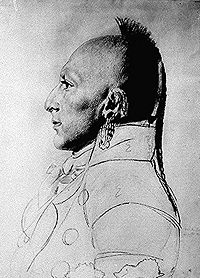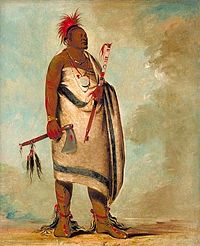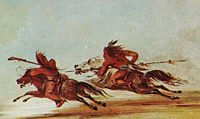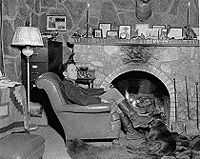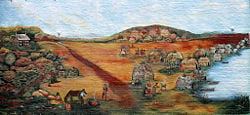Osage Nation
| Osage |
|---|
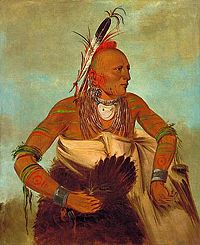
|
| Osage warrior. Painted by George Catlin in 1834. |
| Total population |
| 16,000 |
| Regions with significant populations |
| United States (Oklahoma) |
| Languages |
| English, Osage |
| Religions |
| Christianity, other |
| Related ethnic groups |
| other Siouan peoples |
The Osage Nation is a Native American tribe in the United States, which is mainly based in Osage County, Oklahoma, but can be found throughout America.
The Osage were originally known by Ni-U-Kon-Ska, which means meaning "Children of the Middle Waters." Today they call themselves Wah-Zhá-Zhi, which was translated by French explorers as Ouazhigi, which later became the English name Osage. They were said to be the tallest Native people in North America, and were greatly feared in war by neighboring tribes.
In the late seventeenth through early nineteenth centuries the Osage thrived on fur trading with French settlers in the Mississippi Valley. However, they were forcibly relocated to Kansas in the nineteenth century, and then relocated to Oklahoma where they prospered in the twentieth century due to mineral and oil discoveries on their land.
Contemporary Osage revere their native culture but do not try to live in the past. They live in the present, able to prosper with the resources they have in the modern world. They continue to conduct some traditional ceremonies, which serves as a way to gather as a people and be recognized as Osages, an identity of which they can remain proud.
History
The Osage language belongs to the Dhegihan branch of the Siouan stock of Native American languages, now spoken in Nebraska and Oklahoma. They originally lived among the Kansa, the Ponca, the Omaha, and the Quapaw in the Ohio Valley. Before the arrival of Europeans, the Osage were a powerful tribe roaming a vast region of North America. They had migrated from the Eastern coast, first settling in the Piedmont Plateau, and then moving to The Ozarks and the prairies of what is now Missouri. The tribes separated there, with the Osage inhabiting villages along the Osage River, where they were first encountered by Jacques Marquette in 1673.
European encounters
The French encountered the Osage in Missouri during the late seventeenth century. As experienced warriors, the Osage allied with the French against the Illiniwek during the early eighteenth century.
Friendly relations with the Osage enabled French fur trader René Auguste Chouteau to extend his business, and he monopolized trade with the tribe from 1794 to 1802.
Lewis and Clark reported that in 1802, the tribe comprised the Great Osage on the Osage River, the Little Osage upstream, and the Arkansas band on the Vermillion River, a tributary of the Arkansas River. The tribe then numbered some 5,500.
Wealthy fur trader Jean Pierre Chouteau, a half-brother of René Auguste Chouteau, became the United States agent for the tribe in 1804. He founded the Saint Louis Missouri Fur Company in 1809 with a family member, Auguste Pierre Chouteau. The Spanish imprisoned Auguste in Santa Fe, New Mexico, in 1817, but released him after several months. He actively traded with the Osage and made his home at Salina, Oklahoma.
Osage persistently resisted changing their ways to match the lifestyle of the settlers, continuing to dress and live in their traditional ways. They also discouraged the use of alcohol, introduced by traders. Christian missionaries tried largely in vain to win converts among the tribe (Rollings 2004). In 1846, the Mission of St. Francis was established among the Osage, on Neosho River, by Fathers John Shoenmakers and John Bax, who extended their ministration also to the Quapaw for some years.
Treaties and relocation
The Osage began treaty-making with the United States in 1808 with the first secession of lands in Missouri (Osage Treaty). In exchange for access to the trading post above the Missouri River in the Treaty of Fort Clark the Osage ceded all of their lands east of the fort in Louisiana Territory effectively leaving them with a small band of territory on the extreme western border of Missouri.
William Clark on the Lewis and Clark Expedition had noted the spot on June 23, 1804, writing:
The wind was against us this morning ⦠were obliged to lie-to during the day at a small island ⦠directly opposite, on the south, is a high commanding position, more than 70 feet above the high water mark, and overlooking the river which is here but of little depth⦠This spot has many advantages for a fort and trading house with the Indians (Rogers 2002).
Also, in 1804 Pierre Chouteau of the Chouteau fur trading family and an agent for the Osage took Osage chiefs to meet President Thomas Jefferson who promised to build them a trading post.
In 1808, Chouteau negotiated a deal for the fort to be built for the protection of the Osage. The specific terms of the deal stated:
The United States being anxious to promote peace, friendship, and intercourse with the Osage tribes, to afford them every assistance in their power, and to protect them from the insults and injuries of other tribes of Indians, situated near the settlements of the white people, have thought proper to build a fort on the right bank of the Missouri, a few miles above the Fire Prairie, and do agree to garrison the same with as many regular troops as the President of the United States may, from time to time, deem necessary for the protection of all orderly, friendly and well disposed Indians of the Great and Little Osage nations, who reside at this place, and who do strictly conform to, and pursue the counsels or admonitions of the President of the United States through his subordinate officers (Kappler 1904).
In order to get the protection, the Osage ceded all of Missouri east of the fort. The Great Osage were to receive $1,000 and the Little Osage were to get $500.
The Osage moved from their homelands on the Osage River in 1808 and moved to western Missouri. The major part of the tribe had moved to the Three-forks region of what would become Oklahoma soon after the arrival of Lewis and Clark. Since this part of the tribe did not participate in the negotiations for the treaty of 1808, their assent was obtained in 1809.
Between that first treaty conducted in the wake of the Louisiana Purchase and 1825, the Osages ceded their traditional lands across Missouri, Arkansas, and Oklahoma. They were first moved onto a southeast Kansas reservation in the Cherokee Strip, on which the city of Independence, Kansas now sits. Subsequent treaties and laws through the 1860s further reduced the lands of the Osage. It was many years before the Osage recovered from the hardship suffered during their years in Kansas, and their enforced removal to their new home. Many adjustments to their new way of life had to be made. During this time, Indian Office reports show nearly a 50 percent decline in the Osage population. This was due to inadequate medical supplies and scarcity of food and clothing.
In 1833, the Osage clashed with the Kiowa near the Wichita Mountains in modern day south central Oklahoma in an incident known as the Cutthroat Gap Massacre. The Osage cut off the heads of their victims and arranged them in rows of brass cooking buckets. Not a single Osage died in this attack. Later, Kiowa warriors, allied with the Comanche, raided the Osage and others.
In 1867, because of their scouting expertise, excellent terrain knowledge, and military prowess, Lt. Col. George Armstrong Custer employed Osage scouts in his campaign against Chief Black Kettle and his band of Cheyenne and Arapaho Indians in western Oklahoma near the Washita River. Chief Black Kettle and his band were taken by surprise in the early morning by Custer and his soldiers, believed to have been led there by Osage scouts. Chief Black Kettle was killed, along with others from both sides. This incident became known as the Battle of Washita River.
An act of Congress on July 15, 1870, provided that the remainder of the Osage land in Kansas be sold and the tribe relocated to Indian Territory in the Cherokee Outlet, becoming the only American Indian nation to buy their own reservation. The reservation is conterminous with present day Osage County, Oklahoma, in the north-central portion of the state between Tulsa, Oklahoma and Ponca City, Oklahoma.
For agricultural purposes, their new land was the poorest in the Indian Territory. At first they existed by subsistence farming. However, they were fortunate to have lands covered with the rich bluestem grass, which proved to be the best grazing in the entire country, and so they profited from leasing grazing rights to cattle ranchers.
Natural resources and headrights
Unlike most other tribes, the Osage unexpectedly stumbled upon a valuable natural resource on their reservation lands that allowed them to financially prosper. In 1894 large quantities of oil was discovered to lie deep beneath the vast prairie the tribe owned. Because of his recent discoveries of oil in southern Kansas, Henry Foster, a petroleum developer, approached the Bureau of Indian Affairs (BIA) to request that they allow him exclusive privileges to explore the Osage reservation for oil and natural gas. The BIA granted his request in 1896, with the stipulation Foster was to pay the Osage tribe at that time a ten percent royalty on all sales of petroleum produced on the reservation.
The Osage had experience with the government and, through the efforts of Principle Chief James Bigheart, negotiated to maintain mineral rights to their new reservation lands, which was later found to have great amounts of crude oil. They were unyielding and held up statehood for Oklahoma before signing an Allotment Act. The Osage Allotment Act was passed on June 28, 1906. This act stated all persons listed on tribal rolls prior to January 1, 1906, or born before July 1907 would be allocated a share of the reservation's subsurface natural resources, regardless of blood quantum.
After mineral leases were auctioned by the tribe and explored, the oil business on the Osage reservation boomed. Overnight, Osage share holders became in the words of many the "richest people in the world" (The New York Times 1921). When royalties peaked in 1925, annual headright earnings were $13,000. A family of four who were all on the allotment role would earn $52,800.
Although the Osage Allotment Act protected the tribe's petroleum interests, the surface land was sold freely by any adult of a sound mind. In the time between 1907 and 1923, thousands of acres of land that were formerly restricted were sold or leased to non-Indian persons. Many Osage at this time did not understand the intricacies or value of these contracts. In 1921, Ernest Burkhart, a white man, married into an Alottee family and with the help of his uncle and brother plotted to murder those that would inherit the headrights. This became known as the Osage Indian Murders. This violence led Congress to pass legislation limiting inheritance of headrights to only those with Osage Indian blood and required those with no degree of Osage Indian blood to sell their shares to the tribe. Today, headrights have been divided among the Osage descendants of those who originally possessed them, although it is estimated that 25 percent of headrights are owned by non-Osage people (The Osage Nation 2006).
Culture
The Osage were among the prairie division of the Plains Indians, semi-nomadic in lifestyle. From their traditional homes in the woodlands of present-day Missouri and Arkansas, the Osage would make semi-annual buffalo hunting forays out into the Great Plains to the west as well as hunt deer, rabbit, and other wild game in the central and eastern parts of their domain. They grew corn, squash, and other vegetables near their villages, and they harvested nuts and wild berries.
They were tall and fierce warriors, greatly feared by neighboring tribes. On his travels in 1834, George Catlin wrote that they appeared
to be the tallest race of men in North America, either red or white skins; there being fe indeed of the men at their full growth who are less than six feet in stature, and very many of them six and a half, and others seven feet (Catlin 2004).
Catlin also noted their fearlessness as warriors:
The Osages have been formerly, and until quite recently, a powerful and warlike tribe; carrying all their arms fearlessly through to all these realms and ready to cope with foes of any kind that they were liable to meet (Catlin 2004).
By the time Catlin encountered them, however, they had suffered through relocations, war, and disease, which had greatly reduced their numbers although not their spirit.
Religion
A spiritual people, the Osage held pantheistic beliefs. They regarded all life forms and changes in the universe as the product of a single mysterious life-giving force called Wa-kon-tah, the great mystery spirit or great power. Children of the earth do not understand the mystery of Wa-kon-tah until they have passed on into the realm of the "Great Mysteries." People were one manifestation of Wa-kon-tah, as were all living things. Their clan totems were considered different manifestations of Wa-kon-tah.
Their creation myths told of a time when the People of the Sky (Tzi-sho) met the People of the Land (Hun-kah) to form one tribe. This tribe were called the Children of the Middle Waters (Ni-u-ko'n-ska) who became the Osage.
The Osage had rituals for significant events in lifeâchild naming, mourning, war, peace, and the like. Other rituals were performed seasonally: a ritual in spring cleansed the village and prepared for planting; a planting ritual was held at the time of planting; and in the late summer when the corn began to ripen they held a green corn ceremony. The Osage had sacred fires and at one time a ritual renewal of fires. They also held initiation rituals for "little-old-men," who served as their priests and elders, keepers of the traditions. Only a "little-old-man" had the authority to perform the portion of a ritual for the clan to which he belonged.
Art
The Osage men were proud of their appearance, plucking the hair from their faces and eyebrows and shaving their heads to leave only a tuft on the top which became a pigtail in the back. They also adorned themselves with beads and bones from their ears, and had many tattoos on their bodies.
Artworks include headdresses and war clubs for warriors; dance costumes, wedding dresses, fans, rattles, and other items display fancy beadwork and ribbons; practical items like cradle boards and blankets show commitment to utility while showing the decorative motifs of their artistic tradition. The Osage have not commercialized their art, their artisans typically making items only for their own families or members of their community (Bailey et al. 2004).
Contemporary Osage
Today, the Osage Nation claims more than 10,000 members. The Osage Tribal Museum in Pawhuska, Oklahoma, the oldest tribally-owned museum in the country, documents their history.
The Osage Nation sponsors pow-wows. Of particular note is the four-day series of dances and rituals held in June, the I'n-Lon-Schka, the "playground of the eldest son." During the ceremony a new drum keeper, always an eldest son is chosen. Other eldest sons also are presented as their "coming of age" rite of passage through the introduction-to-the-dance ceremony. This ceremony is significant, particularly to contemporary Osage who have had to deal with issues of allotment of headrights and blood quantum, binding together the community in their recognition of the importance of the eldest son (Callahan 1993).
For contemporary Osage, their native culture is a respectful memorial of their past. They do not try to re-create the past that has already gone, but rather live in the present and participate in the ceremonies that remain. This brings tribal members back to the reservation, to gather as a people, commune with each other, and be recognized as Osages.
Notable Osage
- White Hair
White Hair (not White Feather), is the English name for the Osage Chief Pawhuska for whom the town of Pawhuska, Oklahoma is named.
- Maria Tallchief
Ballerina Maria Tallchief, an Osage born in 1925 in Fairfax, Oklahoma, contributed greatly to the success of ballet dance in America. From 1942 to 1947 she danced with the Ballet Russe de Monte Carlo, but she is best known for her time with the New York City Ballet. Choreographer George Balanchine, to whom she was married (1946 to 1952) wrote several of his most famous works for her. She was the first prima ballerina of the New York City Ballet from 1947 to 1960, where Balanchine was the principal choreographer. Her performance of Balanchine's The Firebird in 1949 and their earlier collaboration at the Paris Opera elevated Maria Tallchief onto the world stage. She also originated the role of the Sugarplum Fairy in Balanchine's version of The Nutcracker.
- Marjorie Tallchief
Maria's younger sister, Marjorie Tallchief, also performed as a dancer. She was the first Native American to be "première danseuse étoile" of the Paris Opera Ballet.
- John Joseph Mathews
John Joseph Mathews (c. 1894-1979) was a World War I veteran who became one of the Osage Nation's most important spokespeople and writers. He studied at the University of Oklahoma and Oxford and served as a flight instructor during World War I.
- Clarence Leonard Tinker
Clarence Leonard Tinker (1887-1942), one-eighth Osage, was an officer in the U.S. military. He was promoted to Major General, the first Native American to attain that rank. He was the first American General killed in World War II when his plane crashed into the Pacific Ocean during the Battle of Midway on June 7, 1942. He received the Soldier's Medal in 1931 and was posthumously awarded the Distinguished Service Medal. Tinker Air Force Base in Oklahoma City, Oklahoma is named in his honor.
ReferencesISBN links support NWE through referral fees
- Bailey, Garrick Alan (ed.). 1999. The Osage and the Invisible World: From the Works of Francis La Flesche. Norman, OK: University of Oklahoma Press. ISBN 0806131322.
- Bailey, Garrick Alan, Daniel C. Swan, John W. Nunley, and E. Sean Standingbear. 2004. Art of the Osage. University of Washington Press. ISBN 0295983876.
- Burns, Louis F. 2004. A History of the Osage People. University of Alabama Press. ISBN 0817350187.
- Callahan, Alice Anne. 1993. The Osage Ceremonial Dance I'n-Lon-Schka. University of Oklahoma Press. ISBN 0806124865.
- Catlin, George. [1903] 2004. North American Indians. Penguin Classics. ISBN 978-0142437506.
- Hogan, Laurence J. 1998. The Osage Indian Murders: The True Story of a 21-Murder Plot to Inherit the Headrights of Wealthy Osage Tribe Members. Amlex. ISBN 096591741X.
- Kappler, Charles J. (ed.). 1904. Treaty with the Osage, 1808. Indian Affairs: Laws and Treaties. Vol. II, Treaties. Washington DC: Government Printing Office. Retrieved November 3, 2008.
- Rogers, Ann. 2002. Lewis and Clark in Missouri. Columbia, MO: University of Missouri Press. ISBN 0826214150.
- Rollings, Willard Hughes. 2004. Unaffected by the Gospel: Osage Resistance to the Christian Invasion, 1673-1906: A Cultural Victory. Alburqueque, NM: University of New Mexico Press. ISBN 978-0826335586.
- The New York Times. 1921. Osage Are Richest People: Greatest Per Capita Wealth in World Results From Oil Deal. The New York Times, June 25, 1921, 3. Retrieved November 3, 2008.
- The Osage Nation. 2006. Frequently Asked Questions and Answers About the Osage Mineral Estate. The Osage Nation Mineral Council.
- United States Census Bureau. 2005. American Indian, Alaska Native Tables from the Statistical Abstract of the United States: 2004-2005. Statistical Abstract of the United States.
- Waldman, Carl. 2006. Encyclopedia of Native American Tribes. New York, NY: Checkmark Books. ISBN 978-0816062744.
External links
All links retrieved November 17, 2022.
- Osage Nation Official Website
- Osage Tribe at Access Geneology
| ||||||||
Credits
New World Encyclopedia writers and editors rewrote and completed the Wikipedia article in accordance with New World Encyclopedia standards. This article abides by terms of the Creative Commons CC-by-sa 3.0 License (CC-by-sa), which may be used and disseminated with proper attribution. Credit is due under the terms of this license that can reference both the New World Encyclopedia contributors and the selfless volunteer contributors of the Wikimedia Foundation. To cite this article click here for a list of acceptable citing formats.The history of earlier contributions by wikipedians is accessible to researchers here:
The history of this article since it was imported to New World Encyclopedia:
Note: Some restrictions may apply to use of individual images which are separately licensed.
